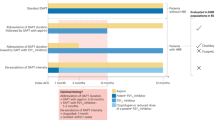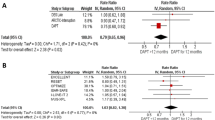Abstract
Objectives
To investigate the influence of dual antiplatelet therapy vs. aspirin alone on local platelet activation and clinical endpoints in patients with PAD treated with endovascular therapy.
Methods
Patients received either 500 mg aspirin and 300 mg clopidogrel before intervention followed by a daily dose of 100 mg aspirin and 75 mg clopidogrel for 6 months, or the same doses of aspirin plus placebo instead of clopidogrel. Primary endpoints were local concentrations of platelet activation markers β-thromboglobulin and CD40L, and the rate of patient’s resistant to clopidogrel. Secondary endpoints included the clinical development 6 months after the intervention.
Results
Eighty patients, 40 in each group, were enrolled. The median peri-interventional concentration of β-TG was 224.5 vs. 365.5 (P = 0.03) in the clopidogrel and placebo group. The concentration of CD40L was 127 and 206.5 (P = 0.05). Thirty per cent of patients who had received clopidogrel were resistant. Two clopidogrel and eight placebo patients required TLR (P = 0.04). The clopidogrel patients who needed revascularisation were both resistant to clopidogrel. Minor bleeding complications occurred in one clopidogrel and two placebo patients.
Conclusion
Dual antiplatetet therapy reduces peri-interventional platelet activation and improves functional outcome without higher bleeding complications. An individual tailored dual antiplatelet therapy seems desirable for endovascularly treated patients with PAD.
Key Points
• The role of clopidogrel and aspirin following endovascular therapy was investigated.
• Dual antiplatelet therapy reduces peri-interventional platelet activation more than aspirin alone.
• Dual antiplatelet therapy improves the outcome of endovascularly treated patients.
• Clopidogrel resistance is important when treating peripheral arterial disease endovascularly.




Similar content being viewed by others

Abbreviations
- ABI:
-
ankle-brachial index
- ß-TG:
-
ß-thromboglobulin
- CD40L:
-
human soluble CD40 ligand
- PAD:
-
peripheral arterial disease
- PTA:
-
percutaneous transluminal angioplasty
- SAE:
-
serious adverse events
- SD:
-
standard deviation
- TLR:
-
target lesion revascularisation
References
Norgren L, Hiatt WR, Dormandy JA, Nehler MR, Harris KA, Fowkes FG, TASC II Working Group (2007) Inter-Society Consensus for the Management of Peripheral Arterial Disease (TASC II). J Vasc Surg 45:5–67
Chan AW, Moliterno DJ, Berger PB et al (2003) Triple antiplatelet therapy during percutaneous coronary intervention is associated with improved outcomes including one-year survival: results from the Do Tirofiban and ReoProGive Similar Efficacy Outcome Trial (TARGET). J Am Coll Cardiol 42:1188–1195
Mehta SR, Yusuf S, Peters RJ et al (2001) Effects of pretreatment with clopidogrel and aspirin followed by long-term therapy in patients undergoing percutaneous coronary intervention: the PCI-CURE study. Lancet 358:527–533
Steinhubl SR, Berger PB, Mann JT 3rd et al (2002) Early and sustained dual oral antiplatelet therapy following percutaneous coronary intervention: a randomized controlled trial. JAMA 288:2411–2420
The CAPRIE Steering Committee (1996) A randomized, blinded, trial of clopidogrel versus aspirin in patients at risk of ischemic events (CAPRIE). Lancet 348:1329–1339
Dörffler-Melly J, Koopman MM, Prins MH, Büller HR (2005) Antiplatelet and anticoagulant drugs for prevention of restenosis/reocclusion following peripheral endovascular treatment. Cochrane Database Syst Rev 1:CD002071
Davì G, Patrono C (2007) Platelet activation and atherothrombosis. N Engl J Med 357:2482–2494
Ruggeri ZM (2002) Platelets in atherothrombosis. Nat Med 8:1227–1234
Chandrasekar B, Tanguay JF (2000) Platelets and restenosis. J Am Coll Card 35:555–562
Cassar K, Ford I, Greaves M, Bachoo P, Brittenden J (2005) Randomized clinical trial of the antiplatelet effects of aspirin-clopidogrel combination versus aspirin alone after lower limb angioplasty. Br J Surg 92:159–165
Cassar K, Bachoo P, Ford I, Greaves M, Brittenden J (2005) Clopidogrel has no effect on D-dimer and thrombin-antithrombin III levels in patients with peripheral arterial disease undergoing peripheral percutaneous transluminal angioplasty. J Vasc Surg 42:252–258
Burdess A, Nimmo AF, Garden OJ et al (2010) Randomized controlled trial of dual antiplatelet therapy in patients undergoing surgery for critical limb ischemia. Ann Surg 252:37–42
Geisler T, Langer H, Wydymus M et al (2006) Low response to clopidogrel is associated with cardiovascular outcome after coronary stent implantation. Eur Heart J 27:2420–2425
Hochholzer W, Trenk D, Bestehorn HP et al (2006) Impact of the degree of peri-interventional platelet inhibition after loading with clopidogrel on early clinical outcome of elective coronary stent placement. J Am Coll Cardiol 48:1742–1750
Sibbing D, Morath T, Braun S et al (2010) Clopidogrel response status assessed with Multiplate point-of-care analysis and the incidence and timing of stent thrombosis over six months following coronary stenting. Thromb Haemost 103:151–159
Tepe G, Schmehl J, Wendel HP et al (2006) Reduced thrombogenicity of nitinol stents–in vitro evaluation of different surface modifications and coatings. Biomaterials 27:643–650
Kaplan KL, Owen J (1981) Plasma levels of beta-thromboglobulin and platelet factor 4 as indices of platelet activation in vivo. Blood 57:199–202
Henn V, Slupsky JR, Gräfe M et al (1998) CD40 ligand on activated platelets triggers an inflammatory reaction of endothelial cells. Nature 391:591–594
Soga Y, Yokoi H, Kawasaki T et al (2009) Efficacy of cilostazol after endovascular therapy for femoropopliteal artery disease in patients with intermittent claudication. J Am Coll Cardiol 53:48–53
Cassar K, Bachoo P, Ford I, Greaves M, Brittenden J (2006) Variability in responsiveness to clopidogrel in patients with intermittent claudication. Eur J Vasc Endovasc Surg 32:71–75
Ziegler S, Maca T, Alt E, Speiser W, Schneider B, Minar E (2002) Monitoring of antiplatelet therapy with the PFA-100 in peripheral angioplasty patients. Platelets 13:493–497
Linnemann B, Schwonberg J, Toennes SW, Mani H, Lindhoff-Last E (2010) Variability of residual platelet function despite clopidogrel treatment in patients with peripheral arterial occlusive disease. Atherosclerosis 209:504–509
Ciuffetti G, Lombardini R, Pirro M, Lupattelli G, Mannarino E (2001) Clopidogrel: hemorheological effects in subjects with subclinical atherosclerosis. Clin Hemorheol Microcirc 25:31–39
Jagroop IA, Matsagas MI, Geroulakos G, Mikhailidis DP (2004) The effect of clopidogrel, aspirin and both antiplatelet drugs on platelet function in patients with peripheral arterial disease. Platelets 15:117–125
Wilson AM, Brittenden J, Bachoo P, Ford I, Nixon GF (2009) Randomized controlled trial of aspirin and clopidogrel versus aspirin and placebo on markers of smooth muscle proliferation before and after peripheral angioplasty. J Vasc Surg 50:861–869
Schillinger M, Sabeti S, Loewe C et al (2006) Balloon angioplasty versus implantation of nitinol stents in the superficial femoral artery. N Engl J Med 354:1879–1888
Krankenberg H, Schlüter M, Steinkamp HJ et al (2007) Nitinol stent implantation versus percutaneous transluminal angioplasty in superficial femoral artery lesions up to 10 cm in length: the femoral artery stenting trial (FAST). Circulation 116:285–292
Capek P, McLean GK, Berkowitz HD (1991) Femoropopliteal angioplasty. Factors influencing long-term success. Circulation 83:I70–I80
Berger PB, Bhatt DL, Fuster V et al (2010) Bleeding complications with dual antiplatelet therapy among patients with stable vascular disease or risk factors for vascular disease: results from the Clopidogrel for High Atherothrombotic Risk and Ischemic Stabilization, Management, and Avoidance (CHARISMA) trial. Circulation 121:2575–2583
Bonello L, Camoin-Jau L, Arques S et al (2008) Adjusted clopidogrel loading doses according to vasodilator-stimulated phosphoprotein phosphorylation index decrease rate of major adverse cardiovascular events in patients with clopidogrel resistance: a multicenter randomized prospective study. J Am Coll Cardiol 51:1404–1411
Aleil B, Jacquemin L, De Poli F et al (2008) Clopidogrel 150 mg/day to overcome low responsiveness in patients undergoing elective percutaneous coronary intervention: results from the VASP-02 (Vasodilator-Stimulated Phosphoprotein-02) randomized study. JACC Cardiovasc Interv 1:631–638
Pena A, Collet JP, Hulot JS et al (2009) Can we override clopidogrel resistance? Circulation 119:2854–2857
Wiviott SD, Braunwald E, McCabe CH et al (2007) Prasugrel versus clopidogrel in patients with acute coronary syndromes. N Engl J Med 357:2001–2015
Wallentin L, Becker RC, Budaj A et al (2009) Ticagrelor versus clopidogrel in patients with acute coronary syndromes. N Engl J Med 361:1045–1057
Acknowledgments
Relationship with industry: The study was an investigator-initiated study supported by Sanofi-Aventis S.A., Paris, France
F.F. Strobl received a grant from Interfakultäres Zentrum für Klinische Forschung (IZKF), Tübingen, Germany, for this study.
We thank Christoph Meissner, Institute for Medical Information Processing, Tübingen, Germany, for statistical analysis.
Author information
Authors and Affiliations
Corresponding author
Rights and permissions
About this article
Cite this article
Tepe, G., Bantleon, R., Brechtel, K. et al. Management of peripheral arterial interventions with mono or dual antiplatelet therapy—the MIRROR study: a randomised and double-blinded clinical trial. Eur Radiol 22, 1998–2006 (2012). https://doi.org/10.1007/s00330-012-2441-2
Received:
Revised:
Accepted:
Published:
Issue Date:
DOI: https://doi.org/10.1007/s00330-012-2441-2



